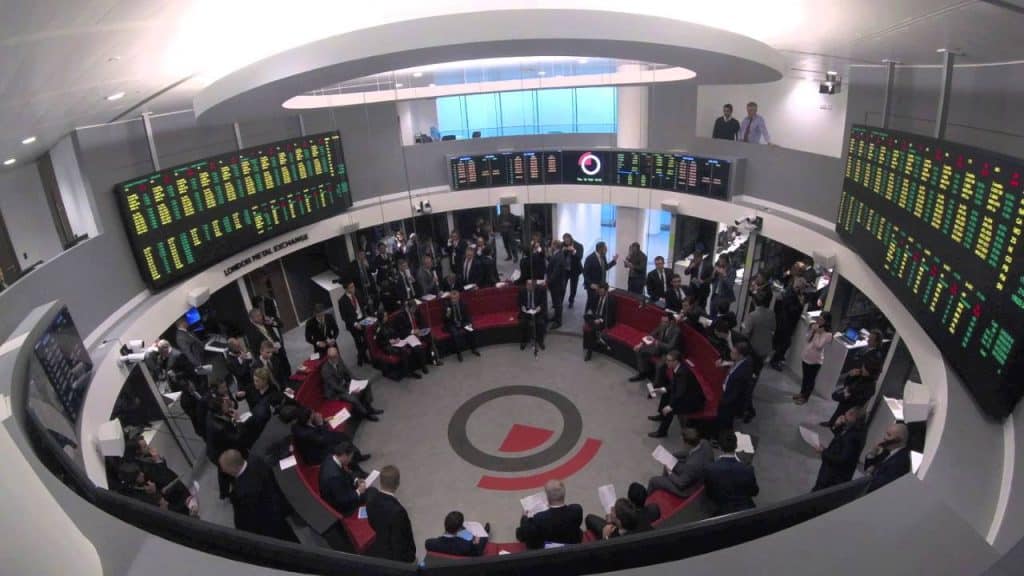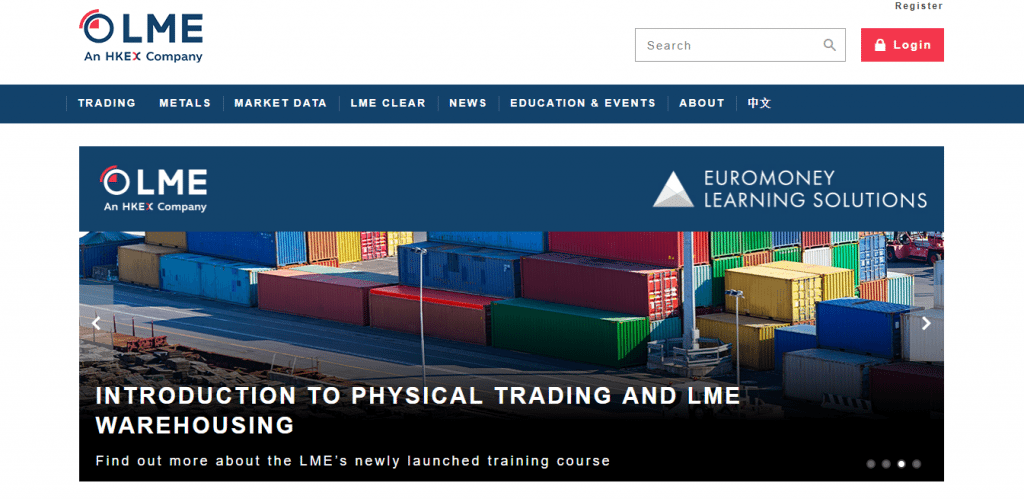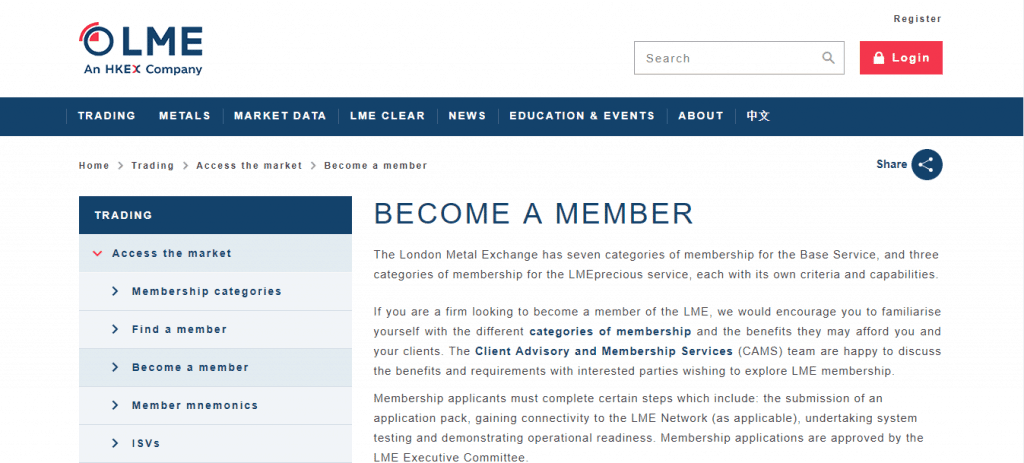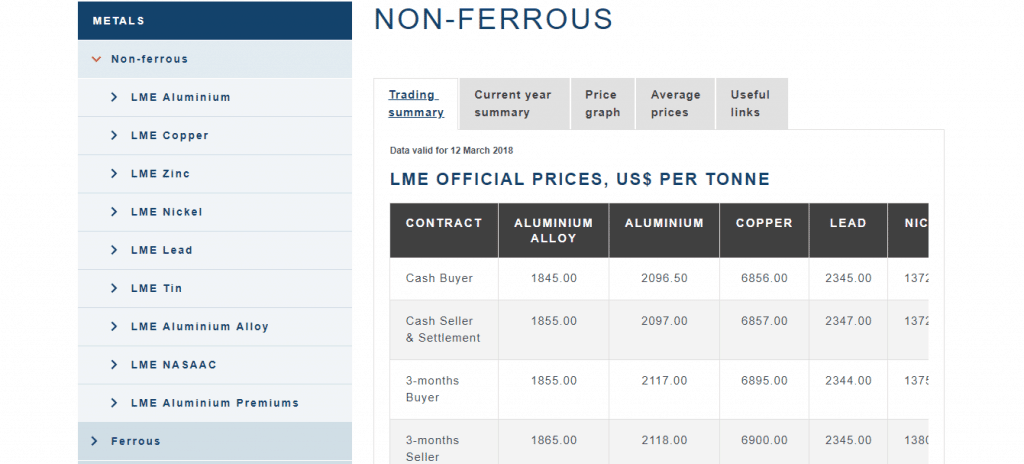The London Metal Exchange (LME) is the world’s central marketplace for industrial metals trading. In this guide, you’ll learn how the LME operates, what you can trade, and how to get started trading.
Contents
What is the London Metal Exchange?
The London Metal Exchange (LME) is a futures and options trading exchange that operates the world’s largest marketplace for trading base metals.
The LME transacts about 176 million lots of metals annually, which equates to about $13.5 trillion. Trading on the LME often surpasses global metal production by a factor of 40.
Base metals play a critical role in many industries including construction, manufacturing, power, and storage. The LME provides a regulated and efficient marketplace for metals producers, consumers, and speculators to transact business.
The LME offers the following products and services related to trading metals.
| Service | Description |
|---|---|
| Trading Venues | The LME operates three distinct regulated platforms for trading metals. |
| Physical Market Services | LME assists metal producers and consumers with hedging and managing risk. |
| Warehousing | To accommodate physical delivery of metals, LME approves and licenses a network of metals storage facilities around the globe. |
| Systems | LME employs systems and technologies that assist with straight-through trade processing, inventory management, trade matching, trade registry, and other services necessary for a well-functioning physical commodities market. |
| Branding | LME approves metals for warehousing only if they conform to specifications on quality, shape and weight LME branding provides buyers with assurances about the quality of metals they are purchasing. |
What Can You Trade on the LME?
LME traders can transact business in the following types of derivatives contracts:
- Futures – A futures contract is an obligation to buy or sell a standard quantity of a specified asset (metal) on a particular date at a fixed price agreed upon today.
- Options – An option provides the buyer with the right, but not the obligation, to buy or sell an asset (metal) at a particular price and on a particular future date.
- Traded Average Price Options (TAPOs) – TAPOs depend on the monthly average settlement price (MASP) for the contract month.
- Monthly Average Futures – MAFs are a type of swap that allows traders to hedge against the monthly average price. Traders enter into a fixed price contract and settle against the MASP at the end of the averaging period.
- HKEX London Minis – Cash-settled futures contracts denominated in Chinese renminbi instead of US dollars.
- LMEminis – Futures contracts on smaller-sized copper, aluminum, and zinc lots that are cash-settled.
Metals List
The LME offers customers access to trading and/or clearing four categories of metals.
| Category | Metals | Trading Products |
|---|---|---|
| Non-Ferrous Metals | Aluminum | F, O, TAPO, MAF, LMEM, HKEX |
| Copper | F, O, TAPO, MAF, LMEM, HKEX | |
| Zinc | F, O, TAPO, MAF, LMEM, HKEX | |
| Nickel | F, O, TAPO, MAF, HKEX | |
| Lead | F, O, TAPO, MAF, HKEX | |
| Tin | F, O, TAPO, MAF, HKEX | |
| Aluminum Alloy | F, O, TAPO, MAF, HKEX | |
| North American Special Alloy Aluminum Contract (NASAAC) | F, O, TAPO, MAF | |
| Aluminum Premiums | Contracts designed to help industry hedge the premium portion of the aluminum price. LME offers four types of aluminum premium contracts:
|
|
| Ferrous Metals | Steel Scrap | F (Cash-settled futures) |
| Steel Rebar | F (Cash-settled futures) | |
| Precious Metals | Gold | F |
| Silver | F | |
| Palladium Platinum | LME works with the London Platinum and Palladium Market to administer and distribute London Bullion Market Association (LBMA) Platinum and LBMA Palladium Prices. | |
| Minor Metals | Cobalt | F |
| Molybdenum | F |
How to Start Trading Metals
Many regulated brokers worldwide offer metals trading in various forms, including shares of mining companies, CFDs, bullion, and more.
Traders in can open an account at one of these regulated brokerage firms and begin trading CFDs and other derivatives based on LME products.
CFDs are complex instruments and come with a high risk of losing money rapidly due to leverage. Between 74%-89% of retail investor accounts lose money when trading CFDs. You should consider whether you can afford to take the high risk of losing your money.
LME Trading Venues and Platforms
The LME uses three venues to conduct trading on its exchange:
The Ring
The Ring is the open-outcry physical trading floor that plays a key role in price discovery on the LME.
Each metal is traded in a highly liquid five-minute open-outcry trading session.
LME futures contracts trade daily out to three months, weekly out to six months and monthly up to 123 months in the future depending on the metal.
Only an LME Ring member can transact business in the Ring. Ring trading begins at 11:40 and ends at 17:00. Traders should consult the LME website for the specific trading windows for individual metals.

Electronic Trading
The LME operates two electronic trading platforms – LMEselect and LMEbullion.
LMEselect
LMEselect is the electronic trading platform used most by traders.
The platform is specially designed to work with the exchange’s prompt date structure. This structure enables futures participants to actively hedge their risk down to the exact day.
LMEselect offers these features to traders:
- Low latency – The platform integrates with member trading platforms through a FIX API either from member sites or data centers. This enables traders using the platform to react quickly to real-time data.
- Convenient Access – Clients can access the system either through member systems or Independent Software Vendor Platforms (ISVs).
- LMEselect Data – Traders can directly access the electronic order book with LMEselect Data. LMEselect Data also provides traders with tick data, Open High Low Close (OHLC) information, and price and trading reports.
LMEbullion
LMEbullion is a real-time auction system. The LME conducts auctions twice a day for palladium and platinum to determine the AM and PM established prices.
LME electronic trading hours are from 01:00 to 19:00 London time.
Telephone
The LME operates an inter-office telephone market for trading 24 hours a day. The exchange matches, settles, and clears telephone trades the same way it does trades conducted in the Ring or electronically.
How Is the LME Regulated?
The LME is regulated by different entities in the jurisdictions in which it operates:
United Kingdom
The LME is a Recognised Investment Exchange (RIE) and is regulated directly by the Financial Conduct Authority (FCA). The FCA is a UK financial regulatory body that operates as a non-governmental watchdog group for the financial services industry.
The LME also operates within the regulatory framework of the Financial Services and Markets Act 2000. This Act of the Parliament of the United Kingdom created an agency – Financial Services Authority (FSA) – to regulate investment businesses.
The Act defines the conditions under which the LME operates and requires it, as an RIE, to maintain orderly markets in its contracts.
United States
When the LME conducts business in the United States, it falls under the jurisdiction of the Commodities and Futures Trading Commission (CFTC) and relevant US legislation.
The CFTC mission is to facilitate “open, transparent, competitive, and financially sound markets.” The agency works to limit systemic problems and safeguard market participants, consumers, and the general public from fraud, manipulation, and abusive practices.
European Union
The Markets in Financial Instruments Directive (MiFID) (*an EU regulation designed to increase transparency across all member nations) and its successors MiFID II and Markets in Financial Instruments Regulation (MiFIR) place certain requirements on trading firms.
These changes went into effect in January 2018. MiFID II made the reporting requirements of derivative contracts more stringent. Commodity contracts are subject to position limits under MiFID II and more onerous reporting requirements.
The LME believes it has instituted the necessary changes to its operations to comply with MiFID II requirements.
Arbitration
LME operates a private dispute resolution system to adjudicate disputes between traders and member firm fairy and economically.
LME arbitration rules require that the parties to a dispute allow a third party to make an independent and binding decision about the outcome.
History of the London Metal Exchange
Although the LME was formally founded in 1877, its origins trace back to the reign of Queen Elizabeth I.
In 1571, traders formed the Royal Exchange in London to trade physical metals for the domestic market. However, as Britain’s international role expanded, the nation soon became a leading exporter of metals.
European merchants began arriving in London to partake in the growing metals trade. By the early 19th century, it had grown so large that the Royal Exchange no longer provided an adequate venue for transacting business.
Individual traders began meeting in local coffee houses and soon created the concept of the Ring. A merchant would draw a circle with sawdust on the floor of a coffee shop and call out “Change.” Traders would then gather around the circle and call out bids and offers. The Ring formed the basis for the open-outcry trading floor on the LME.
The Industrial Revolution in the 19th century led to profound changes in metals consumption. The United Kingdom, which heretofore had been self-sufficient in copper and tin, now required the importation of large tonnages from abroad. This change caused problems for metals consumers and producers.
Ships carrying metals from Malaya and China often took months to arrive in British ports. Metals buyers had no way of knowing what the prices would be when the shipments finally arrived. Metals sellers feared prices might drop by the time their shipments arrived.
To solve this problem, merchants and buyers began transacting forward contracts to lock in prices for future deliveries.
The expanding trade in metals and forward contracts led to the formal establishment of the London Metals and Mining Company in 1877. Membership increased rapidly, and soon the exchange moved to a larger facility. Today the LME occupies a modern facility in Finsbury Square in central London.

On December 6, 2012, Hong Kong Exchanges and Clearing (HKEX) purchased LME for £1.4 billion. LME Holdings Limited became a member of the HKEX Group and is the sole shareholder of LME.
FAQs
Here are some answers to commonly-asked questions about the LME.
What Types of Memberships Does LME Offer?
LME has seven categories of membership within the base metal service and three categories of membership within its LMEprecious service.
Base Metal Membership Categories
| Category | Trading Rights | Clearing Rights |
|---|---|---|
| 1 | ||
| 2 | ||
| 3 | ||
| 4 | ||
| 5 | Not clearing members | |
| 6 | Individuals in industry that want an association with LME. | |
| 7 | Honorary memberships granted at the discretion of the Directors. |
LME Base memberships in categories one to four require regulation by the FCA unless they have exclusion under the Financial Service and Markets Act of 2000.
LMEprecious Membership Categories
| Service | Description |
|---|---|
| General Clearing Member (GCM) | Can trade and clear LMEprecious contracts on behalf of themselves and their clients. |
| Individual Clearing Member (ICM) | Can trade and clear LMEprecious contracts on behalf of themselves. |
| Non-Clearing Member |
Individuals wishing to apply for LME membership must complete several steps:
- Submit an application pack
- Gain connectivity to LME Network
- Complete System Testing
- Demonstrate Operational Readiness
The LME Executive Committee must approve all members. Prospective members should consult the LME membership section of the website for forms and more details.

What Are LME Margin Requirements?
LME uses the Standard Portfolio Analysis of Risk (SPAN®) Margin Model to calculate the initial margin required for a position.
SPAN® considers the trader’s entire portfolio to determine how it will respond to changes in factors such as volatility and futures prices. The model simulates potential scenarios to see how the P&L performs under these assumptions.
SPAN® takes the following four areas into consideration when calculating initial margin for a portfolio:
- Scanning Risk: This is the “worst-case” portfolio loss based on shifts to currencies, volatilities and other important variables.
- Inter-prompt Spread: This model assumes that forward prices move by identical amounts across all prompt dates.
- Inter-Credit Spread: The model reduces the riskiness of a position by applying offsets for positions in related contract that might reduce risk.
- Short Option Minimum Charge: This relates to the costs of closing out deeply out-of-the-money options.
Traders post initial margin based on the riskiness of a position and any possible offsets the model may apply. However, LME Clear must ensure that the exchange employs the necessary procedures to protect market integrity and safeguard market participants from systemic risk.
LME Clear may require additional margin to account for factors such as illiquidity, concentration risk in an asset class or other factors.
Traders can consult the LME website for more details about how LME Clear calculates margin.
What Fees and Charges Apply At the LME?
LME charges several types of fees to traders:
- Transaction Fees – These include trading and clearing fees and vary according to the trading venue, product, contract type, and other factors.
- Subscription and Facilitation Fees – These fees vary by membership category and include application fees for trading and clearing memberships.
- Market Data Fees – These fees vary based on the type of data being purchased, the number of licensed users, and the specific plan for purchasing the data.
- Miscellaneous – Other LME fees include warehousing fees, brand listing fees, and fees for other proprietary services the exchange offers.
What Market Data Does LME Make Available?
LME makes several types of market data and licenses available to market participants:
LME Prices
LME publishes official and closing prices for metals traded on the exchange.
These prices derive directly from trading and are used for futures settlements and margin calculations. The LME Asian reference price provides an early indication of metals prices based on trading in Asian markets.

The following market data may be valuable for traders developing strategies for trading:
| Market Data | Description |
|---|---|
| Reports by Metal | Reports that include prices, forward curves, inventory stocks and volumes for each metal. |
| Monthly Average Settlement Price (MASP) | These historical reports detail the MASP for each metal traded on the exchange. |
| Monthly Overview | A quick-reference PDF that provides an overview of important data for all contracts and individual metals. |
| Open Interest | The LME publishes both an exchange and a market open interest report. |
| Commitment of Traders Report (COTR) | A report that categorizes open interest data by the classification of type of trader. |
| Futures Banding | Daily report showing the number of market participants holding futures positions as a percentage of market open interest. |
| Warrant Banding | Daily report showing the number of market participants with a concentration of LME warrants |
| Volumes | LME publishes both an annual and a monthly report showing daily, average per contract and per metal volumes. |
| LME Clear Reports | LME Clear produces a variety of reports in different format for members. Reports include trading activity, open positions, settlement, risk, expiry, fees and cash movement related activities. |
| Warehouse and Stock Reports | These reports include opening and closing stocks, stock movements, wait times and cancelled and live warrants across locations and metals. |
What Educational Materials Does LME Offer?
The education section of the LME website is divided into three categories:
- Events
- Online Resources
- In-Person Training
Events
LME attends and sponsors many industry conferences and events throughout the year. Traders should consult the calendar on the website for a list of upcoming events and registration information.
Online Resources
LME Online Resources include the following:
- Brochures and Whitepapers – These include guides to the exchange, fact sheets on individual metals, clearing manuals, and research reports.
- Videos – The video library covers a vast array of topics including overviews on futures, warehouses, aluminum premiums, hedging, and more.
- LME Insights – Papers on various market topics.
In-Person Training
Courses include live in-person instruction as well as customized training for organizations and companies in the metals community.
Courses take place in major cities across the globe. Traders can find a schedule and course fees, where applicable, on the LME website.
Does LME Have Vendor Partners?
Members and their clients can access the LMEselect platform via one of the approved ISVs with whom the exchange works.
The list of companies that have passed conformance tests for routing through the LME platform can be found on their website.
Further Reading
- Learn more about the world’s largest commodity exchanges including Euronext, the European Energy Exchange (EEX), the Zhengzhou Commodity Exchange (ZCE), the Deutsche Borse Group, the Multi (CMX) of India, and the Brasil Bolsa Balcão.
- If you’d like a primer on how to trade commodities in general, please see our introduction to commodity trading.


